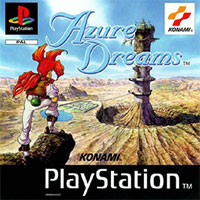
Azure Dreams
Release Date: November 13, 1997
RPG, fantasy, roguelike, manga and anime, dungeon crawler, dating Simulator, jRPG, singleplayer
Hybrid jRPG and roguelike production, enriched with elements taken from dating simulators. As we play, we take control of Kohem, a warrior who travels the floors of the Monster Tower, in search of answers about the mysterious disappearance of his father.
Azure Dreams, developed by Konami, is a hybrid game, combining features characteristic for jRPGs, roguelike, as well as dating simulators.
Story
Azure Dreams takes place in the city of Monsbaiya, which is dominated by a tower known as the Monster Tower. For decades it attracted daredevils who, tempted by the vision of seizing an unimaginable fortune, tried to face the dangers lurking there. Years ago its threshold was crossed by the most powerful warrior the earth saw, Guy, who then disappeared. The main character of the game is his son, Koh, who after reaching the age of fifteen decides to face the challenge and solve the mystery of his father's disappearance. The protagonist is not alone, as he is accompanied by the monster Kewne, and with time other monsters join him as well.
Mechanics
The gameplay in Azure Dreams is based on three pillars. The first of these is the exploration of the tower, the subsequent stories of which are generated procedurally - each time we cross its threshold we have to take into account the need to face different challenges. The dangers waiting for Koh are above all the opponents - the higher the hero manages to reach, the more powerful adversaries we have to face; the ubiquitous traps are also a threat. While traversing the building, we carry out our actions in turn-based mode - this applies both to moving around the environment, as well as attacking, using objects or activating the traps we have set.
Over time, the protagonist gains more and more powerful equipment (in the form of shields and melee weapons), spells, as well as monster eggs. The latter are important because after leaving the tower he can sell them for a considerable amount of money or decide to keep them - with time friendly monsters emerge from them to help him in clashes. What is most interesting, unlike Koh, who travels through the subsequent floors of the Monster Tower always starts on the first level, the experience gained by the allied creatures is not lost, so that after each expedition they increase not only their combat potential but also the capabilities of the hero himself.
The Monster Tower can be escaped in one of three ways - perishing (which leads to the loss of all equipment), sacrificing a monster that accompanies us (although this requires a special item), or finding an item called the Wind Crystal.
The second pillar is the development of the city of Monsbaiya, within which we can build various buildings (such as a theatre, hospital, racetrack, gym or casino). Nothing stands in the way of perfecting the main character's house, enriching it with various decorations, lamps, TV, chairs or even a motorcycle; this is where the hero can raise found monsters. The third pillar is the opportunity to romance female characters - the city is inhabited by eight girls, with whom Koh can become friends and, over time, fall in love; success is ensured primarily by giving them gifts (for example, in the form of flowers). Interestingly, although in the Japanese version of the title it is possible to get married to a chosen girl, the edition, which has found its way to the western markets, has been deprived of this option.
Technical aspects
Azure Dreams's visuals adopt manga style and present a level comparable to other jRPGs. Hiroshi Tamawari is responsible for composing the soundtrack that accompanies us in our struggles.
Last updated on April 17, 2020
Azure Dreams Summary
Platforms:
PlayStation 1